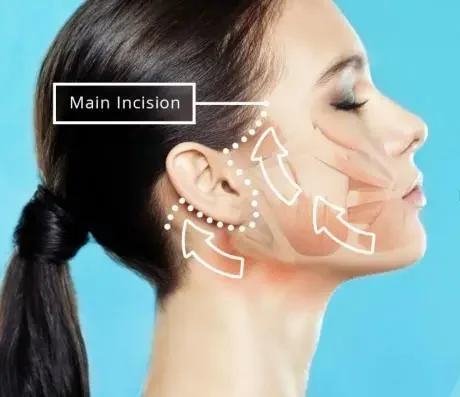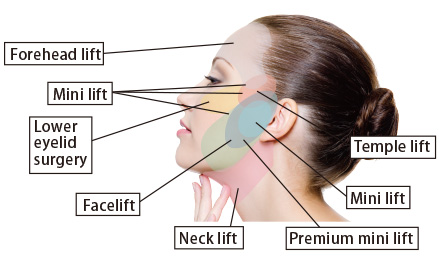Face lift surgery in Iran
Face lift surgery in Iran, also known as rhytidectomy, is a type of cosmetic surgery that aims to rejuvenate the face. This procedure is performed in order to reduce wrinkles and sagging skin caused by aging, reducing skin elasticity, and volume changes in the tissues of the face and neck.
During facelift surgery, a cosmetic surgeon makes incisions in specific areas of the face under general or local anesthesia. These incisions are usually placed in hidden areas such as the hairline or inside the ears to remain hidden from view. The surgeon then pulls back the skin and tightens the underlying tissues, removes excess fat if necessary, and cuts away excess skin. Finally, he glues the skin flat over the face and creates stitches for healing.
Facelift surgery can be performed alone or in combination with other cosmetic surgery procedures such as blepharoplasty (eyelid surgery), rhinoplasty (nose surgery), or liposuction (fat removal).
After surgery, patients usually need a recovery period that can include bruising, swelling, and discomfort. The full recovery period may take several weeks to several months. The results of facelift surgery can be variable and mainly depend on the skill of the surgeon, the age of the patient, and the individual characteristics of the skin and facial tissues.
It is important to consult with a professional and experienced surgeon before undergoing facelift surgery to ensure that this procedure is suitable for your particular situation and to have a detailed understanding of the risks, benefits, and expectations related to the surgical results.
Different types of facelift surgery
There are different types of face lift surgery in Iran, which differ based on the method used and the scope of the operation. Here are some common types of facelift surgery:
1. Traditional face lift surgery in Iran:
This is the most common and comprehensive type of surgery. This surgery involves lifting the skin and subcutaneous tissue in the face and neck area, tightening it again and removing excess skin. Muscles and other tissues may also be reshaped to improve the appearance of the face and neck.
2. Mini face lift:
This type of facelift is considered less invasive. It focuses on lifting and tightening the skin in a specific area of the face, such as the lower jaw or cheeks, rather than the entire face. A partial facelift is suitable for people who suffer from mild to moderate sagging in certain areas.
3. Thread lift surgery:
In this type of face lift, special threads made of soluble materials are used under the skin to lift and tighten it. The threads are held in place by a ligament, resuspending the tissue and lifting the skin. Facial ligature is a less invasive and minimally invasive procedure, but its results are often temporary compared to traditional surgery.
4. Laser face lift surgery:
In this type of face lift, a laser is used to tighten the skin and stimulate collagen production in the facial tissues. With the use of laser, it is possible to reduce the surgical intervention and the long recovery period that may be associated with traditional surgeries.
Remember that before deciding to undergo facelift surgery, you should consult with an expert plastic surgeon to evaluate your situation and guide you towards the most appropriate option for you. Any type of facelift surgery may require judgment and prior preparation, and recovery time and expected results may vary from person to person.
Suitable candidate for face lift surgery in Iran
I cannot diagnose your individual situation or determine whether you are a good candidate for facelift surgery without consulting a medical professional. However, there are general factors that can be considered to determine whether surgery is right for you:
1. Skin sagging:
If you have sagging skin on your face and neck, a facelift may be a good option to improve your appearance.
2. Age:
Face lift is a common procedure among people between 40 and 70 years old. However, there is no specific age for surgery and it depends on your individual circumstances and the recommendations of the plastic surgeon.
3. Public health:
You must be in good general health before any surgery. Your doctor may ask you to undergo certain tests to determine if you are suitable for surgery.
4. Expectations and concerns:
You need to be sure that the surgery will meet your expectations and help you achieve the results you want. Before deciding to have surgery, you should discuss your goals and expectations with your doctor.

What to expect from facelift surgery
From facelift surgery, you can expect some of the following changes and benefits:
1. Improvement of sagging skin:
You’ll notice an improvement in sagging skin on the face and neck as the skin is lifted and tightened for a youthful, revitalized appearance.
2. Reduction of wrinkles and fine lines:
Facial wrinkles and fine lines may disappear or be significantly reduced after surgery.
3. Redefining facial features:
A facelift can improve the definition of facial features, such as improving wrinkles in the forehead, the area around the eyes, and the lower jaw.
4. Re-tightening the facial muscles:
Sagging facial muscles can be reshaped and tightened for a sharper and younger appearance.
5. Improving neck features:
If the surgery involves a skin lift in the neck area, you may notice an improvement in the appearance of the neck and a reduction in sagging skin in this area.
6. Long-term results:
Although the aging process cannot be completely stopped, the results of a facelift can last a long time with proper care and a healthy diet.
Recovery stages after face lift surgery
After face lift surgery in Iran, the patient goes through several stages of healing and recovery. The general stages that a patient may experience after surgery are as follows:
1. The period immediately after the operation:
During this step, your face will be wrapped in bandages and there may be drainage tubes to help drain excess fluid. You may feel swelling and redness in your face and neck.
2. Initial recovery period:
Recovery from surgery usually takes a few days to two weeks. During this period, the patient may feel swelling and bruising in the face and neck area. You may also need to use medications to relieve pain and reduce swelling.
3. Improving swelling and bruising:
Over time, the bruising and swelling will begin to resolve and heal. It may take several weeks for the swelling to go down completely and the bruising to disappear.
4. Recovery of sensitivity and movement:
You may experience some loss of sensation in the face and neck after surgery, but over time, normal sensation can be regained. You may also need some time to get the full facial movements.
5. Final results:
The final results of facelift surgery can appear several weeks or even months after surgery, as the face stabilizes and fully heals. It is important to follow your doctor’s instructions regarding wound care, rest, diet, and personal care.
You should speak with your plastic surgeon to obtain specific information about recovery and recovery stages in your individual case, as these stages can vary based on factors such as the type of surgery, the complexities of the condition, and the overall health of the patient.


